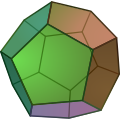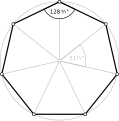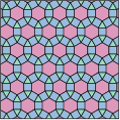Szerkesztő:Bikermacska/próbalap
| Fejes Tóth László | |
 | |
Foto Ludwig Danzer | |
| Életrajzi adatok | |
| Született | 1915. március 12. Szeged |
| Elhunyt | 2005. március 17. (90 évesen) Budapest |
| Születési neve | Tóth László |
| Iskolái | |
| Felsőoktatási intézmény | Pázmány Péter Tudományegyetem |
| Pályafutása | |
| Szakterület | Matematikus, Geométer |
| Kutatási terület | Diszkrét es kombinatorius geometria |
| Munkahelyek | |
| Pázmány Péter Tudományegyetem | tanár (1946-1948) |
| Veszprémi Vegyipari Egyetem | egyetemi tanár (1949-1964) |
| MTA Matematikai Kutatóintézet | matematikus, igazgató |
| Akadémiai tagság | MTA; |
| Hatással voltak rá | Fejér Lipót |
Fejes Tóth László (Szeged, március 12, 1915 – Budapest, március 17, 2005) magyar matematikus es geométer. Bizonyitotta, hogy a racsszeru szerkezetek He proved that a lattice pattern is the most efficient way to pack centrally symmetric konvex halmazs on the Euclidean plane (a generalization of Thue's theorem, a 2-dimensional analog of the Kepler-sejtést).[1] He also investigated the density and configurations of packing spheres. He was the first to show, in 1953, that the Kepler conjecture can be reduced to a finite case analysis and, later, that the problem might be solved using a computer.
A Magyar Tudományos Akadémia (MTA) tagja 1962 ota. Az MTA Matematikai Kutató Intézetben Rényi Alfréd Matematikai Kutatóintézet dolgozott mint matematikus, és 1970-1983 között mint az intézet igazgatója. Számos kitüntetést kapott, köztük Kossuth-díj (1957-ben), Magyar Népköztársaság Állami Díja (1973-ban), Gauss Emlékérem (1977-ben) és Akadémiai Aranyérem (2002)[2][3]
Fejes Tóth Lászlót a diszkrét es kombinatorius geometria alapitójaként tartják számon.[4][5][6]
Early life and career[szerkesztés]
Hargittai Istvánnal 1999-ben készült interjúban István Hargittai[3], Fejes Tóth elmondta, hogy 5 eves korában költözött Budapestre szüleivel. Édesapja vasutas volt, és késöbb megszerezte a jogi diplomát. Édesanyja középiskolai tanár volt. Fejes Tóth már középiskolában elkezdett érdeklödni matematikai problémák iránt, es "nagyjából tisztában volt" a kalkulussal. Fejes Tóth érdeklödese a geometria iránt szintén mar középiskolában, a Széchenyi István Reálgimnáziumban, elkezdodott. Az egyetem elsö évében pedig elkezdett foglalkozni a "cooling of a globe" problémájával.
As described in a 1999 interview with István Hargittai, Fejes Tóth’s father was a railway worker, who advanced in his career within the railway organization ultimately to earn a doctorate in law. Fejes Tóth’s mother taught Hungarian and German literature in a high school. The family moved to Budapest; there Fejes Tóth attended elementary school and high school—the Széchenyi István Reálgimnázium—where his interest in mathematics began. As a freshman in university, he became interested in the cooling of a globe.[3]

Photo by Ludwig Danzer
He received his doctorate at Pázmány Péter Tudományegyetem, now the Eötvös Loránd University, under the direction of Fejér Lipót.[7] After university, he served as a soldier for two years, but received a medical exemption. In 1941 he joined the Kolozsvári Magyar Királyi Ferenc József Tudományegyetem (Cluj).[7] It was here that he became interested in packing problems.[8] In 1944, he returned to Budapest to teach mathematics at Árpád High School. Between 1946 and 1949 he lectured at Pázmány Péter Tudományegyetem and starting in 1949 became a professor at the Veszprémi Egyetem for 15 years,[3] where he was the primary developer of the "geometric patterns" theory "of the plane, the sphere and the surface space" and where he "had studied non grid-like structures and quasicrystals" which later became an independent discipline, as reported by Pach János.[7]
The editors of a book dedicated to Fejes Tóth described some highlights of his early work; e.g. having shown that the maximum density of a packing of repeated symmetric convex bodies occurs with a lattice pattern of packing. He also showed that, of all convex politópok of given surface area that are equivalent to a given szabályos test (e.g. a tetrahedron or a octahedron), a regular polytope always has the largest possible volume. He developed a technique that proved Steiner’s conjecture for the kocka and for the dodekaéder. [8] By 1953, Fejes Tóth had written dozens of papers devoted to these types of fundamental issues.[7] His distinguished academic career allowed him to travel abroad beyond the Vasfüggöny to attend international conferences and teach at various universities, including those at Freiburg, Madison, Wisconsin, Ohio, and Salzburg.[3]
He was the father of three children, two sons—one a professor of mathematics at the Alfréd Rényi Institute of Mathematics, the other a professor of physiology at Dartmouth College—and one daughter, a psychologist.[3] He enjoyed sports, being skilled at table tennis, tennis, and gymnastics. A family photograph shows him doing a hand stand on a high bar at the age of fifty.[7]
Fejes Tóth held the following positions over his career:[2]
- Assistant instructor, University of Cluj (1941-44)
- Instructor, Árpád School (1944-45)
- Lecuturer, Pázmány Péter University (1946-48)
- Professor, University of Veszprém (1949-64)[3]
- Researcher, then director (in 1970), Mathematical Research Institute (Alfréd Rényi Institute of Mathematics) (1965-83)
In addition to his positions in residence, he was a corresponding member of the Saxonian Academy of Sciences and Humanities (Sächsische Akademie der Wissenschaften) and of the Braunschweigische Wissenschaftliche Gesellschaft.
Work on regular figures[szerkesztés]
According to J. A. Todd,[9] a reviewer of Fejes Tóth's book Regular Figures,[10] Fejes Tóth divided the topic into two sections. One, entitled "Systematology of the Regular Figures", develops a theory of "regular and Archimedean polyhedra and of regular polytopes". Todd explains that the treatment includes:
- Plane Ornaments, including two-dimensional crystallographic groups
- Spherical arrangements, including an enumeration of the 32 crystal classes
- Hyperbolic tessellations, those discrete groups generated by two operations whose product is involutary
- Polyhedra, including regular solids and convex Archimedean solids
- Regular polytopes
-
A compact binary circle packing
-
A dense packing of spheres
-
Dodecahedron
(Regular convex polyhedron) -
Small stellated dodecahedron
(Regular star—a concave polyhedron)[11] -
A semi-regular tessellation with three prototiles: a triangle, a square and a hexagon.
The other section, entitled "Genetics of the Regular Figures", covers a number of special problems, according to Todd. These problems include "packings and coverings of circles in a plane, and ... with tessellations on a sphere" and also problems "in the hyperbolic plane, and in Euclidean space of three or more dimensions." At the time, Todd opined that those problems were "a subject in which there is still much scope for research, and one which calls for considerable ingenuity in approaching its problems".[9]
Honors and recognition[szerkesztés]

Bárány Imre credited Fejes Tóth with several influential proofs in the field of discrete and convex geometry, pertaining to packings and coverings by circles, to convex sets in a plane and to packings and coverings in higher dimensions, including the first correct proof of Thue's theorem. He credits Fejes Tóth, along with Erdős Pál, as having helped to "create the school of Hungarian discrete geometry."[6]
Fejes Tóth's monograph, Lagerungen in der Ebene, auf der Kugel und im Raum,[12] which was translated into Russian and Japanese, won him the Kossuth Prize in 1957 and the Hungarian Academy of Sciences membership in 1962.[2][7]
William Edge,[13] another reviewer of Regular Figures,[10] cites Fejes Tóth's earlier work, Lagerungen in der Ebene, auf der Kugel und im Raum,[12] as the foundation of his second chapter in Regular Figures. He emphasized that, at the time of this work, the problem of the upper bound for the density of a packing of equal spheres was still unsolved.
The approach that Fejes Tóth suggested in that work, which translates as "packing [of objects] in a plane, on a sphere and in a space", provided Thomas Hales a basis for a proof of the Kepler-sejtést in 1998. The Kepler conjecture, named after the 17th-century German mathematician and astronomer Johannes Kepler, says that no arrangement of equally sized gömbs filling space has a greater average sűrűség than that of the cubic close packing (face-centered cubic) and hexagonal close packing arrangements. Hales used a proof by exhaustion involving the checking of many individual cases, using complex computer calculations.[14][15][16][17][18]
Fejes Tóth received the following prizes:[2]
- Klug Lipót Prize (1943)
- Kossuth-díj (1957)
- A Magyar Népköztársaság Állami Díja (1973)
- Szele Tibor-emlékérem (1977)
- Gauss Bicentennial Medal (1977)
- Akadémiai Aranyérem (2002)
In 2008, a conference was convened in Fejes Tóth's memory in Budapest from June 30 – July 6;[4] it celebrated the term, "Intuitive Geometry", coined by Fejes Tóth to refer to the kind of geometry, which is accessible to the "man in the street". According to the conference organizers, the term encompasses combinatorial geometry, the theory of packing, covering and tiling, convexity, computational geometry, rigidity theory, the geometry of numbers, crystallography and classical differential geometry.
Partial bibliography[szerkesztés]

Foto: Konrad Jacobs.
- Fejes Tóth, László (1950. április 19.). „Some packing and covering theorems” (angol nyelven). Acta Sci. Math. 12A, 62-67. o.
- Lagerungen in der Ebene, auf der Kugel und im Raum, Die Grundlehren der Mathematischen Wissenschaften in Einzeldarstellungen mit besonderer Berücksichtigung der Anwendungsgebiete (német nyelven). Berlin, New York: Springer-Verlag, 238. o. (1953)
- Fejes Tóth, László. Regular Figures (angol nyelven). Pergamon Press, 339. o. (1964)
- Fejes Tóth, László. Reguläre Figuren (német nyelven). Akadémiai Kiadó, 316. o. (1965)
- Fejes Tóth, László (1971). „Lencsék legsűrűbb elhelyezése a síkban”. Matematikai Lapok 22, 209-213. o.
- Fejes Tóth, László (1986). „Densest packing of translates of the union of two circles” (angol nyelven). Discrete and Computational Geometry 1, 307-314. o.
References[szerkesztés]
- ↑ Fejes Tóth, László (1950. április 19.). „Some packing and covering theorems”. Acta Sci. Math. 12A, 62-67. o.
- ↑ a b c d Kántor-Varga, T.. A Panorama of Hungarian Mathematics in the Twentieth Century, I. Springer, 573-574. o. (2010). ISBN 9783540307211
- ↑ a b c d e f g Hargittai, István: Interjú (Fejes Tóth László). Magyar Tudomány, 2005 (Hozzáférés: 2013. november 16.)
- ↑ a b Pach, János: Intuitive Geometry, in Memoriam László Fejes Tóth. Alfréd Rényi Institute of Mathematics, 2008
- ↑ Katona, G. O. H. (2005). „Laszlo Fejes Toth – Obituary” (angol nyelven). Studia Scientiarum Mathematicarum Hungarica 42 (2), 113. o.
- ↑ a b Bárány, Imre. A Panorama of Hungarian Mathematics in the Twentieth Century, I. Springer, 431-441. o. (2010). ISBN 9783540307211
- ↑ a b c d e f Pach, János: Ötvenévesen a nyújtón—Fejes Tóth László emlékezete (hungarian nyelven), 2005. április 9.
- ↑ a b Bárány, Imre. Geometry - Intuitive, Discrete, and Convex—A Tribute to László Fejes Tóth, Bolyai Society Mathematical Studies. Springer, 7-8. o. (2014)
- ↑ a b Todd, J.A.. Fejes Toth, L., Regular Figures, Proceedings of the Edinburgh Mathematical Society. Cambridge University Press, 174-175. o.. DOI: 10.1017/S0013091500026055 (1964)
- ↑ a b Fejes Tóth, László. Regular Figures (angol nyelven). Pergamon Press, 339. o. (1964)
- ↑ Robert Webb: Stella software http://www.software3d.com/Stella.php
- ↑ a b Lagerungen in der Ebene, auf der Kugel und im Raum, Die Grundlehren der Mathematischen Wissenschaften in Einzeldarstellungen mit besonderer Berücksichtigung der Anwendungsgebiete (német nyelven). Berlin, New York: Springer-Verlag, 238. o. (1953)
- ↑ Edge, W.L. (1965. October). „Regular Figures by L. Fejes Toth” 49, 343-345. o, Kiadó: The Mathematical Gazette.
- ↑ (2000) „Cannonballs and honeycombs”. Notices of the American Mathematical Society 47 (4), 440–449. o. ISSN 0002-9920. An elementary exposition of the proof of the Kepler conjecture.
- ↑ Hales, Thomas C. (1994), "The status of the Kepler conjecture", The Mathematical Intelligencer 16 (3): 47–58, ISSN 0343-6993, DOI 10.1007/BF03024356
- ↑ (2006) „Historical overview of the Kepler conjecture”. Discrete & Computational Geometry. an International Journal of Mathematics and Computer Science 36 (1), 5–20. o. DOI:10.1007/s00454-005-1210-2. ISSN 0179-5376.
- ↑ (2006) „A formulation of the Kepler conjecture”. Discrete & Computational Geometry. an International Journal of Mathematics and Computer Science 36 (1), 21–69. o. DOI:10.1007/s00454-005-1211-1. ISSN 0179-5376.
- ↑ Hales, Thomas C. & Ferguson, Samuel P. (2011), The Kepler Conjecture: The Hales-Ferguson Proof, New York: Springer, ISBN 978-1-4614-1128-4
External links[szerkesztés]
- Hargittai István beszélgetése Fejes Tóth Lászlóval, Magyar Tudomány, 2005. március.
- Pach János: Ötvenévesen a nyújtón, F. T. L. emlékezete, Népszabadság, 2005. április 9.
- Pach János: A geometriai elrendezések diszkrét bája, emlékcikk a KöMaLban.




![Small stellated dodecahedron (Regular star—a concave polyhedron)[11]](http://upload.wikimedia.org/wikipedia/commons/thumb/7/77/Small_stellated_dodecahedron.png/114px-Small_stellated_dodecahedron.png)

